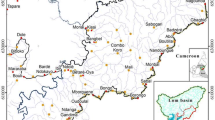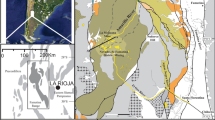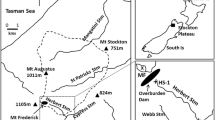Abstract
Cone Pond is one of the few acidic, clear-water ponds in the White Mountains of New Hampshire, a region dominated by high inputs of strong acids from atmospheric deposition and low base content of bedrock. Monitoring was conducted for 13 months to compare and contrast the acid-base chemistry of the terrestrial and aquatic portions of the watershed. Variations in Al concentration and speciation in drainage waters were correlated with changes in the supply of naturally occurring organic ligands. During the study period, the pond retained 28% of Al inputs, including nearly half of the inputs of organically complexed Al. Chemical equilibrium calculations indicated that the entire water-column was oversaturated with respect to the solubility of synthetic gibbsite during summer, as was the hypolimnion during winter. Retention of Al resulted from an increase in pH in the hypolimnion concomitant with SO4 2− reduction, and from loss of organic anions in epilimnetic waters. Acid neutralizing capacity (ANC) generated in the pond primarily through SO4 2− reduction and base cation (C B ) release was balanced by ANC consumed as a result of Al retention.
Similar content being viewed by others
References
American Public Health Association (1985) Standard Methods for the Examination of Water and Wastewater. American Public Health Association, New York
Baker JP, Christensen SW, Creager CS, Warren-Hicks W & Godbout L (1988) Identification of Critical Values for Effects on Fish Populations. Final Report submitted to the US Environmental Protection Agency, Washington, DC
Buso DC, Martin CW & Hornbeck JW (1984) Potential for Acidification of Six Remote Ponds in the White Mountains of New Hampshire. New Hampshire Water Resources Research Center, Durham, Research Report No. 43
Buso DC, Bailey SW, Baird SF, Hornbeck JW & Martin CW (1985) Watershed Interactions Affecting Pond Acidification. New Hampshire Water Resources Research Center, Durham, Research Report No. 62
Chen CW, Gherini SA, Peters NE, Murdoch PS, Newton RM & Goldstein RA (1984) Hydrologic analyses of acidic and alkaline lakes. Water Resour. Res. 20: 1875–1882
Cook RB, Kelly CA, Schindler DW & Turner MA (1986) Mechanisms of hydrogen ion neutralization in an experimentally acidified lake. Limnology and Oceanography. 31: 134–148
Cronan CS, & Schofield CL (1979) Aluminum leaching in response to acid precipitation. Science 204: 304–306
Davis RB, Anderson DS & Berge F (1985) Paleolimnological evidence that lake acidification is accompanied by a loss of organic matter. Nature 316: 436–438
Dahlgren RA, Driscoll CT & McAvoy DC (1989) Aluminum precipitation and dissolution rates in Spodosol Bs horizons in the northeastern USA. Soil Sci. Soc. Am. J. 53: 1045–1054
Dahlgren RA, McAvoy DC & Driscoll CT (1990) Acidification and recovery of a Spodosol Bs horizon from acidic deposition. Environ. Sci. Technol. 24: 531–537
Driscoll CT, Baker JP, Bisogni JJ & Schofield CL (1980) Effect of aluminum speciation on fish in dilute acidified waters. Nature 284: 161–164
Driscoll CT & Bisogni JJ (1984) Weak acid/base systems in dilute lakes and streams in the Adirondack region of New York State. In: Schnoor JL (Ed) Modeling of Total Acid Precipitation Impacts (pp 53–72). Butterworth Publishers, Stoneham, MA
Driscoll CT & Schecher WD (1988) Aluminum in the environment. In: Sigel H (Ed) Metal Ions in Biological Systems, Volume 24, Aluminum and Its Role in Biology (pp 59–122). Marcel Dekker, New York
Driscoll CT, Ayling WA, Fordham GF & Oliver LM (1989) Chemical response of lakes treated with CaCO3 to reacidification. Can. J. Fish. Aquat. Sci. 46: 531–537
Driscoll CT (1991) Northeast Overview. In: Charles DF (Ed) Acidic Deposition and Aquatic Ecosystems (pp129–132). Springer-Verlag, New York
Driscoll CT, Newton RM, Gubala CP, Baker JP & Christensen SW (1991) Adirondack Mountains. In: Charles D (Ed) Acidic Deposition and Aquatic Ecosystems (pp 133–202). Springer-Verlag, New York
Driscoll CT & Van Dreason R (1993) Seasonal and long-term temporal patterns in the chemistry of Adirondack lakes. Water Air Soil Pollut. 67: 319–344
Driscoll CT, Lehtinen MD & Sullivan TJ (1994) Modeling the acid-base chemistry of organic solutes in Adirondack, New York lakes. Water Resour. Res. 30: 297–306
Goulden PD & Brooksbank P (1975) Automated determinations of dissolved organic carbon in lake water. Anal. Chem. 47: 1943–1946
Haines TA & Akielaszek J (1983) A Regional Survey of Chemistry of Headwater Lakes and Streams in New England: Vulnerability to Acidification. USDI Fish and Wildlife Service, Eastern Energy and Land Use Team. FWS/OBS-80
Kahl JS, Cronan CS, Fernandez I.J. Bacon LC & Haines TA (1991) Maine. In: Charles DF (Ed) Acidic Deposition and Aquatic Ecosystems (pp 203– 235). Springer-Verlag, New York
Kahl JS, Haines TA, Norton SA & RB Davis (1993) Recent trends in the acid-base status of surface waters in Maine, USA. Water Air Soil Pollut. 67: 281–300
Krug EC & Frink CR (1983) Acid rain on acid soil: A new perspective. Science 221: 520–525
Landers DH, Overton WS, Linthurst RA & DF Brakke (1988) Eastern lake survey: regional estimates of lake chemistry. Environ. Sci. Technol. 22: 128–135
LaZerte B (1986) Metals and acidification: An overview. Water Air Soil Pollut. 31: 569–576
Likens GE, Bormann FH, Hedin LO, Driscoll CT & Eaton JS (1990) Dry deposition of sulfur: a 23-year record for the Hubbard Brook Forest ecosystem. Tellus 42B: 319–329
Linthurst RA, Landers PH, Eilers JM, Brakke DF, Overton WS, Meier EP & Crowe RE (1986) Characteristics of Lakes in the Eastern United States, Vol 1: Population Descriptions and Physio-Chemical Relationships. EPA-600/4-86-007A, US Environmental Protection Agency, Washington DC
May HM, Helmke PA & ML Jackson (1979) Gibbsite solubility and thermodynamic properties of hydroxy-aluminum ions in aqueous solution at 25°C. Geochim. Cosmochim. Acta. 43: 861–868
McAvoy DC (1988) Seasonal trends of aluminum chemistry in a second-order Massachusetts stream. J. Environ. Quality 17: 528–534
McAvoy DC, Santore RC, Shosa JD & Driscoll CT (1992) Comparison between pyrocatechol violet and 8-hydroxyquinoline procedures for determining aluminum fractions. Soil Sci. Soc. Am. J. 56: 449–455
McSwain MR, Watrous RJ & Douglass JE (1974) Improved methylthymol blue procedure for automated sulfate determinations. Anal. Chem. 46: 1329–1331
Mulder J & Stein A (1994) The solubility of aluminum in acidic forest soils: long-term changes due to acid deposition. Geochim. Cosmochim. Acta. 58: 85–94
Orion (1976) Instruction Manual Fluoride Electrodes. Orion Research, Inc., Cambridge, MA
Santore RC, Driscoll CT & Aloi M (1994) Modeling organic matter and its role in temperate forest soil development. In: Kelly JM & McFee WW (Eds) Carbon Forms and Functions in Forest Soils. Amer. Soc. Agronomy, Madison, WI (in press)
Schafran GC & Driscoll CT (1987) Comparison of terrestrial and hypolimnetic sediment generation of acid neutralizing capacity for an acidic Adirondack lake. Environ. Sci. Technol. 21: 988–993
Schecher WD & Driscoll CT (1994) ALCHEMI: A chemical equilibrium model to assess the acid-base chemistry and speciation of aluminum in dilute solutions. In Leoppert R, Schwab A & Goldberg S (Eds) Chemical Equilibrium and Reaction Models. Soil Sci. Soc. America, Madison, WI (in press)
Schindler DW, Turner MA, Stainton MP & Linsey GA (1986) Natural sources of acid neutralizing capacity in low alkalinity lakes of the precambrian shield. Science. 232: 844–847
Schofield CL, Galloway JN & Hendry GR (1985) Surface water chemistry in the ILWAS basin. Water Air Soil Pollut. 26: 403–423.
Slavin W (1968) Atomic Absorption Spectroscopy. Wiley Interscience, New York
Stoddard JL & Kellogg JH (1993) Trends and patterns in lake acidification in the state of Vermont: evidence from the long-term monitoring project. Water Air Soil Pollut. 67: 301–317
USEPA (1983) Methods for the Chemical Analysis of Waters and Wastes, Environmental Monitoring and Support Laboratory, EPA-600/4-79-020. U.S. Environmental Protection Agency, Cincinnati, OH
Willis RB (1980) Reduction column for automated determination of nitrate and nitrite in water. Anal. Chem. 52: 1376–1377
Author information
Authors and Affiliations
Rights and permissions
About this article
Cite this article
Bailey, S.W., Driscoll, C.T. & Hornbeck, J.W. Acid-base chemistry and aluminum transport in an acidic watershed and pond in New Hampshire. Biogeochemistry 28, 69–91 (1995). https://doi.org/10.1007/BF02180678
Received:
Accepted:
Issue Date:
DOI: https://doi.org/10.1007/BF02180678




